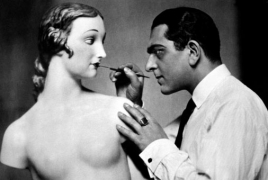
The Museum Ludwig in Cologne, Germany will feature a exhibit of portraits by renowned photographer Karl Schenker, Art Daily reports.
Karl Schenker (1886–1954): the “born portraitist of elegant people,” “a master of several mediums,” “stage director of women’s heads”—the press was enthusiastic about the photographs that made Karl Schenker one of the best-known society photographers in the 1910s and ’20s. Everybody who was anybody had their portrait taken in his Berlin studio on the famous Kurfürstendamm. After all, no one made their subjects look better, and there was no greater master of retouching. He wrapped actresses, dancers, and society ladies in tulle and furs before taking their picture—or he painted the fur into the picture afterwards. The photographer Heinz Hajek-Halke admiringly recalled: “He [Schenker] had taken nude photographs of a respectable ‘lady’—‘… and by all means my husband must never find out!’ He sent the photographs to her home, but showing her dressed in a precious fur that was painted so artfully that one could count every hair. I have seen such works by him and kneeled down.”
As a photographer, illustrator, painter, and for a time even a sculptor, Schenker dedicated himself to creating beautiful portraits of women. He made use of every means of retouching, but surely also the rising cosmetic industry and in some cases presumably the equally young cosmetic surgery. Especially women became formable material, and Schenker had one goal above all: beauty.
Spurred on by the mass dissemination of silent movie star portraits, Schenker’s images attest to a growing media awareness. His works bring to light the beginnings of a passion for the public image, for pictorial beautification. This is carried to extremes in a series of photographs showing wax mannequins created and dressed by his own hand. A journalist coquettishly asks in an article: “living models or wax mannequins?”
Little is known about Schenker’s life and work. Born in 1886 in Bukovina (Romania), he came to Berlin via Lviv and Munich around 1911, where he established a flourishing studio. In 1925 he moved to New York for five years, where he mainly illustrated and painted portraits under the name Karol Schenker. After 1930, back in Berlin, his name appears as an advertising photographer in magazines. But after 1934 the trail goes cold. Facing persecution as a Jew, in 1938 he emigrated to London, where he opened a studio on Regent Street. He died in London in 1954. His mannequin photographs attracted attention once again in 2013, when Cindy Sherman showed them at the Venice Biennale.
The Museum Ludwig recently acquired around 100 portraits and is taking this as an occasion to trace Schenker’s life and work for the first time and to rediscover an unjustly forgotten artist. Around 250 works will be presented, including international loans: photographic portraits of once-famous women and men, fashion and wax figure photographs, magazine covers designed by Schenker, an original drawing, a painting, movie star postcards—even collectible images from cigarette packages. To rediscover Karl Schenker is to rediscover a photographer who transformed his models in his works into the glamorous creatures they wanted to be seen as.
The catalog is edited by Miriam Halwani, with texts by Wolfgang Brückle, Sophia Ebert, Miriam Halwani, Matthias Harder, Eckhard Köhn, Hanne Loreck, Dorothy Price, Sabine Schnakenberg, and Theresia Ziehe, as well as historical texts by Florence van Kirk, Max Osborn, Johanna Thal and Karl Schenker. Published by Verlag der Buchhandlung Walther König, in German and English, ca. 230 pages, 24 x 30 cm, hardcover, museum price: €30, retail price: €38.

